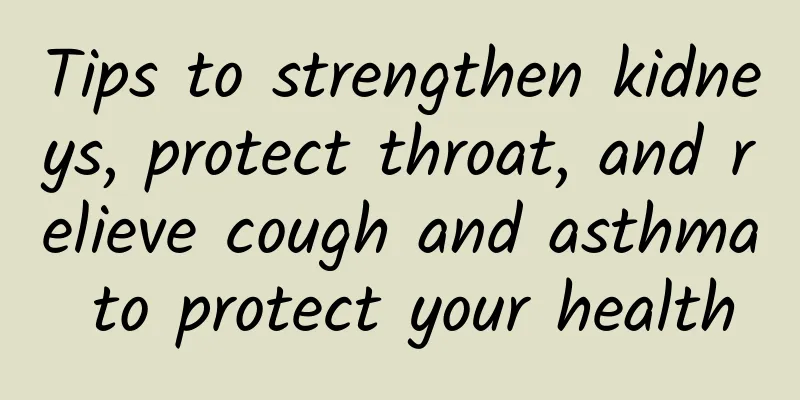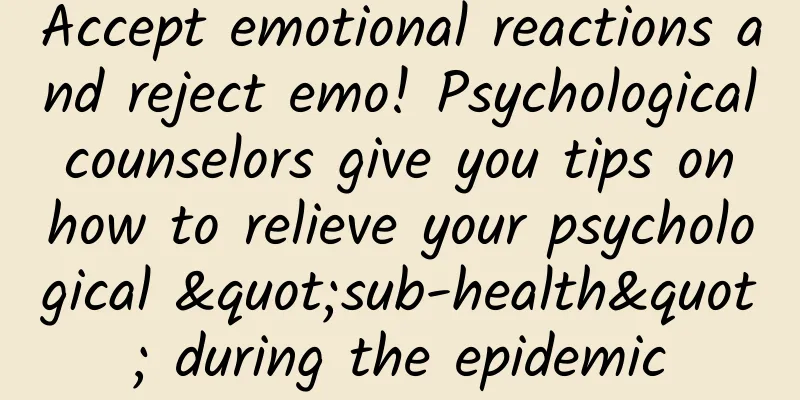Tips to strengthen kidneys, protect throat, and relieve cough and asthma to protect your health

|
In life, we will inevitably encounter various trivial problems. Mastering some tips for healthy living may help you solve life's problems. Let's take a look at the editor's summary! Relieve cough and asthma by pressing two points Autumn and winter are the seasons when respiratory diseases are more common, with common symptoms such as cough and asthma. In addition to treating the primary lung diseases that cause cough and asthma, Chinese medicine can also improve cough and asthma symptoms through external treatments. Among them, Fenglong acupoint and Yuji acupoint are the "killers" for cough and asthma. Fenglong acupoint is a point on the Stomach Meridian of Foot-Yangming. The organs connected to the Stomach Meridian of Foot-Yangming include lips, throat, etc., and its collaterals connect to the throat and pharyngeal isthmus downwards. It can treat diseases in the meridians and relax the bronchi to achieve the effect of expectoration and cough relief. Yuji acupoint is a point on the Lung Meridian of Hand-Taiyin. Asthma and other symptoms of lung diseases are often treated with Yuji acupoint as an auxiliary treatment in clinical practice. How to use these two acupoints to improve cough and asthma symptoms? 1. Massage: Use the tip of your thumb to press down hard on the acupoints, and massage left and right to feel soreness and swelling. When massaging, the thumb should be slightly bent, and a little effort should be used to keep it slightly bent to avoid long-term massage or improper force causing thumb damage. Massage for 2 to 3 minutes every day. 2. Scraping: Fully expose the two acupoints, evenly apply scraping oil or vaseline on the skin, hold the scraping board at a 45-degree angle to the skin and scrape downward (always in one direction, do not scrape back and forth), first with light and slow, and after adaptation, the operation can be gradually increased and accelerated, to the extent that you can tolerate, until the sha appears. 3. Moxibustion: Use moxa sticks to gently moxibustion the acupoints for 20 to 30 minutes, once a day. If your throat is uncomfortable, rub your thumb As the weather gradually becomes drier, many people have symptoms of throat discomfort such as coughing and sore throat. If the symptoms are relatively mild, acupoint massage can be used as an auxiliary treatment on the basis of standardized treatment and medication. Traditional Chinese medicine believes that to relieve throat discomfort, you can start with the "hands". The ancient book "Lingshu Benshu" records that Shaoshang acupoint is an important acupoint on the hand Taiyin lung meridian and a well point of the lung meridian (located at the end of the finger or toe, meaning that the qi of each meridian originates from here), which has the effect of clearing the lungs and relieving pain. Therefore, this acupoint has a good effect on relieving and regulating coughs, sore throats and other problems caused by the failure of the lungs to descend. Acupoint location: Shaoshang is located on the outside of the thumb, about 0.1 inch away from the corner of the nail. Specific method: When massaging, first use the tip of your fingernail to gently pinch the Shaoshang acupoint for about 10 seconds, then use the belly of your finger to massage for 1 to 3 minutes. You can also use chopsticks, pen tips and other round-headed objects for acupressure. Sitting with straight legs strengthens the waist and kidneys The waist connects the upper and lower parts of the body and is the "mainstay" of the human body. However, unhealthy lifestyles such as driving instead of traveling and lack of exercise are gradually "bending" our originally straight waists. From the perspective of traditional Chinese medicine, there is an invisible "belt" around the waist called the belt meridian, which can "bind all the meridians" and constrain other meridians running up and down like a rope, thereby strengthening the connection between the meridians. Therefore, a strong waist helps to move the waist, abdomen and lower limbs, and dominate the activities of the body. In addition, traditional Chinese medicine often says that "the waist is the home of the kidneys" and "the source of life and will is in the waist gap". A bad waist will directly affect the health of the kidneys, resulting in symptoms of kidney deficiency such as sore waist and knees, lack of energy, fatigue and forgetfulness. We might as well strengthen the waist and kidney through some small exercises in daily life, such as the "straight-legged sitting" exercise. This method is derived from the traditional Tai Chi waist relaxation method, which can help stretch the waist muscles, relax the lumbar spine and the ligaments around it, promote the circulation of qi and blood in the meridians near the belt meridian, and make the waist movements more flexible and relaxed. When practicing, you can sit on a hard bed with a thin mattress, first adjust your breathing, close your eyes slightly, and retract your lower jaw slightly; stretch your legs as much as possible, put your feet together, and stand up your toes; lean forward slightly, and the torso and thighs should preferably be slightly less than 90 degrees. Then, follow the breathing to adjust the waist. When you take a deep breath, the waist protrudes backwards, and there is a feeling of relaxation backwards; when you exhale, retract the waist, and at the same time, the pelvis opens to both sides, and the sacrum and coccyx protrude backwards. While taking a deep breath, the perineum can be tightened and loosened at the same time, and the toes follow a little bit, which can strengthen the perineum, help the muscle groups at the root of the thigh relax, and enhance the exercise effect. Patients with spinal trauma, ankylosing spondylitis, lumbar disc herniation, hypertension, cerebrovascular disease, etc. should not practice blindly, and it is best to follow the doctor's instructions. Three tests to warn of stroke "The storm is coming", and the same is true for stroke (also known as apoplexy). There will be some early warning signals before the onset of an attack. If you can find it in time and deal with it scientifically, you may be able to "escape the disaster". Here, we recommend three tests to help you find clues of a stroke in advance. "120" mirror test. The brain stem is the center of life activities. It controls breathing, heartbeat, circulation, etc. If the brain stem is damaged, even a mild stroke may cause serious symptoms. Patients can do the "120" test in front of the mirror to check whether the brain stem is damaged. Specific method: Look in the mirror to see if the face is symmetrical, whether the corners of the mouth are crooked, whether the puffed mouth leaks air, and whether the teeth are symmetrical? Check the two arms, raise them in parallel, whether one side is weak, whether there will be problems with the upper limbs gradually drooping and the palms facing inward. 0 (Listen) Listen to the language, whether the speech is unclear, whether it is difficult to express, and whether the tone of speech becomes low. The test of difficulty standing with eyes closed. This test mainly checks whether the cerebellum is damaged. The cerebellum mainly controls our balance ability. If the cerebellum is infarcted, it is difficult to maintain balance when standing with eyes closed. Specific method: During the test, stand with your feet together, stretch your hands forward, open your eyes first and then close them. If you sway or fall when opening and closing your eyes, you should consider cerebellar infarction. There are several other symptoms of cerebellar stroke, such as dizziness. This type of dizziness is different from dizziness caused by high blood pressure, which often manifests as persistent dizziness accompanied by dizziness, headache, etc. Dizziness that occurs before cerebellar stroke is often related to changes in body position. Dizziness worsens when the body position changes, and disappears after stabilization, with transient vertigo as the main symptom. Cerebellar stroke can also manifest as difficulty walking straight, like drinking too much alcohol; hands are not accurate, and when using chopsticks to pick up things, the closer you get to the target, the less accurate it becomes. Paresis test. This test is divided into upper and lower limbs, and can test whether the brain is damaged. The specific method of the upper limb extension test: raise both upper limbs horizontally, palms down, and hold for 30 seconds. The upper limbs of the paretic will gradually droop and the palms will face inward. Lower limb paresis test: lie flat, bend both knees at right angles, hold for 30 seconds, and the lower leg of the paretic side will gradually fall. If one side of the limb slowly droops unconsciously during the test, it proves that the test is positive. If you have the above problems and are accompanied by some related symptoms, such as sudden forgetfulness, making mistakes when speaking, anomia, visual field loss, double vision, fear of going downstairs, numbness in the hands and face, asymmetry of the two sides of the face, weakness in the limbs, and sudden recurrent choking and coughing, it is recommended to seek medical attention in time. |
<<: Why does water appear when marinating pork (animal cells have water and lose water)?
Recommend
What are the causes of delayed menstruation due to endocrine disorders?
The phenomenon of delayed menstruation is a probl...
What is breast pain?
Chest pain is usually caused by many reasons, whi...
What are some recipes for women to replenish blood and qi?
There are thousands of ways for women to become b...
How many months is it normal to have fetal movement?
For friends who have just become pregnant, they a...
When is the right time to put fish in fish soup? Why do you put fish in fish soup first?
We all know that there are many ways to eat fish,...
What are the dangers of endometrial polyps?
Endometritis is a common disease among women. Thi...
The state of your stool is closely related to your body’s health. If any of these abnormalities occur, be careful!
“Have a nice poop today” This is a gift from mode...
New healthy trend: Adults add some milk every day
With the rapid development of my country's ec...
The difference between having a period and being pregnant
Menstruation is a physiological phenomenon that o...
What does cervical biopsy mean?
Cervical puncture biopsy is a biopsy of the cervi...
What to do if you have back pain in late pregnancy
We all know that the closer a woman gets to her d...
What's wrong with vaginal bleeding other than menstruation?
Menstrual bleeding for female friends is a very n...
Is it a big problem to have breast nodules?
Breast nodules are a common breast disease in wom...
How to treat suppurative mastitis? Scientific treatments include these
Women's breasts can develop many types of inf...









